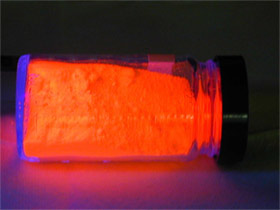triboluminescence

Triboluminescent material exposed to UV light. Credit: Sandia Labs.
Triboluminescence is a form of luminescence ('cold' light emission) caused by adding mechanical energy to certain substances by rubbing, scratching, striking, or crushing.
Some adhesive tapes shown a faint blue triboluminescence when stripped from a roll. Another well-known example of a triboluminescent material is WintOGreen Lifesavers.1 The sugar crystals in these candies triboluminesce mainly in the ultraviolet range, and the wintergreen oil fluoresces in the blue range when excited by the ultraviolet emitted by the sugar.
Many other materials, both organic and inorganic, including quartz and diamond, display the phenomenon. Although the underlying mechanism is still not fully understood, it is believed to be connected with asymmetric crystal structure. Bonds are broken along planes that are oppositely charged. When these positive and negative charges try to get back together, they jump across the rift, emitting light like miniature lightning bolts.


